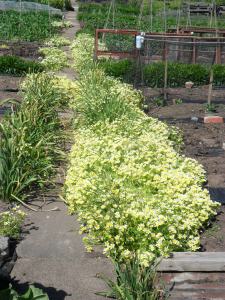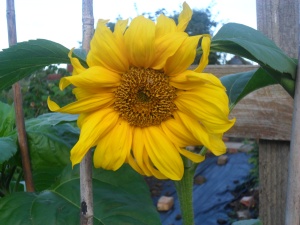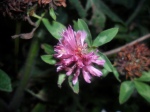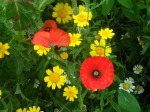It has felt like summer has finally arrived this week and it’s been too hot for me in the garden, though I am not complaining as my garden has loved the sunshine at last and so has Judy….
.
What I have noticed at our local park this week:
.
This year the park keepers have left some grass areas uncut at our local park and for the last few weeks I have seen different wildflowers growing. These flowers may not be unusual, but on mass they have looked stunning.
It started with the dandelions which are a common perennial herb that are part of the sunflower family. This is the weed we all tend to dread in our gardens as they spread so easily, but they have so many uses and they really are a fascinating plant:
“Dandelions prefer chalk and loamy soils above a pH of 7.0. It has been found in prehistoric deposits, and has been recorded up to 2,700 feet in Britain.
The flower opens in the morning and then closes in the evening and a flower head can produce up to 400 seeds, but the average is 180. A plant may have a total of 2,000 to 12,000 seeds and individual plants may survive for 10 to 13 years in undisturbed sites”
No wonder the average gardener doesn’t like them!
(Below is a brilliant photo that my daughter took):
After the dandelions the buttercups emerged coating the field with pretty yellow flowers which are still there at the moment and look spectacular on the field backed by the bright white cow parsley.
I also noticed the buttercups at the side of a busy main road road last week as we were driving home….nature is so wonderful! I wonder how many people in cars have driven past this display without even noticing.
But this week it is the turn of the red clover flowers and the ox-eye daisy and the display is the most impressive of all to me:
I’m not sure if the council are trying to save money by not mowing the grass in certain areas, or if the flowers were intentional….whatever the reason, the outcome is beautiful and there are insects buzzing all around!
.
Flowers in my kitchen garden this week:
.
Nature manages to put flowers in every little suitable spot it can. Unfortunately, our allotments and kitchen gardens need most of the space to be taken up by fruit and vegetables, but by leaving a few nettles at the back of your plot and adding flowers in every suitable spot available (as nature does), we can attract many insects to out plots – which in turn will pollinate our crops and feed on the ‘nasty’ bugs that we don’t want AND look pretty:
.
Four of the ‘good’ bugs attracted to flowers:
Bees – Flowers encourage bees, which in turn pollinate your crops. They are active from late winter until autumn, so I try really hard to have plants in flower during all these months.
Lacewings – These are voracious predators as the larvae and adults feed on caterpillars, thrips, mealy bugs and aphids. They are especially attracted by Cosmos flowers, coreopsis and sweet alyssum.
Soldier Beetles – Unfortunately these beetles do eat the good bugs as well as the bad, but they do help to control aphids and caterpillars. They particularly like catnip and goldenrod.
Ladybirds (sometimes called Lady beetles or lady bugs) – Ladybirds love to eat aphids, scales, spider mites, mealy bugs, etc. which is why most people recognize these as a beneficial insect. It’s their larvae that eat the most of the ‘bad’ insects and can get an infestation under control in no time. Ladybirds are attracted to the parsley family i.e. parsley, dill, fennel, carrots etc.
.
.
If you look closely in the photograph above you can see two bees on my comfrey flowers. It was easy to take photo’s of the bees as there were so many buzzing around the plant….this also applies to the chive flowers which line my central path and lookgreat at the moment:
.
For years I have grown Calendula as they look so pretty and self seed like mad so you only need to buy a packet of these seeds once….and the flowers are edible and the petals look fabulous scattered over a bowl of salad. This week my first two flowers appeared:
I used to grow nasturtiums around my dalek compost bins at the allotment, as these help to surpress weeds nicely….they also provide great ground cover around longer growing vegetables like brussells, spring broccoli and kale. They attract blackfly so I continue to plant them in my kitchen garden around my runnerbeans as sacrificial plants (so the blackfly stay away from my beans) and as a bonus, the nasturtium leaves taste ‘peppery’ and again they are nice in a salad.
At my allotment I used to grow sweet peas near runnerbeans to attract beneficial insects to pollinate them, so I get more beans to pick. This year in my much smaller kitchen garden I have planted the sweetpeas in eight different places to attract insects, to look pretty and to pick a few to bring into our house as they smell wonderful….they are just beginning to flower now:
Previously at my allotment I lined my paths with lavender and poached egg plants, again to attract beneficial insects that love the flowers. The poached egg plants surpress weeds by covering the ground and self seeds easily….any plants that I didn’t want to keep would be dug into the soil and act as a green manure…..I really must find a place for some of these flowers next year in my kitchen garden:
Previously I also grew Sunflowers at the allotment as the birds loved to feed on the seed heads in autumn…again I will be looking to see if I can fit a dwarf variety in my garden somewhere next year too:
This year I planted tagetes and marigolds near my tomatoes in my greenhouse and along my central path in my kitchen garden as these help to deter white flies. Both of them are now beginning to flower:
.
.
Years ago when I took on my first allotment I was told I grow too many flowers and plots were for fruit and vegetables. I am really hoping that my blog inspires other people to grow a few flowers around their plots, as there are so many benefits for the organic grower.
.
I’ll finish today with a few photo’s of flowers growing in my small kitchen garden at the moment. However, I am hoping there will be plenty more still to come over the coming weeks:
.
Thank you for reading my blog today, I will be back next Friday as usual.
Have a great weekend!
XX





























































































































































































































































